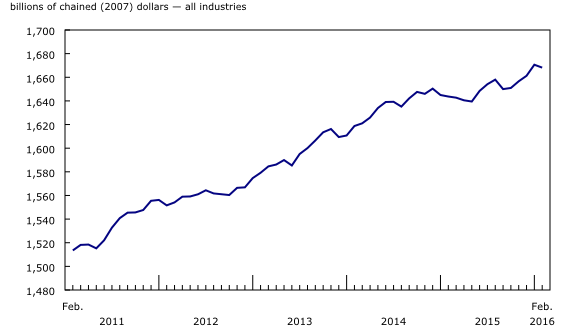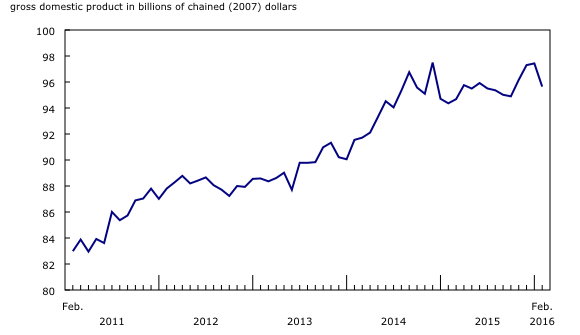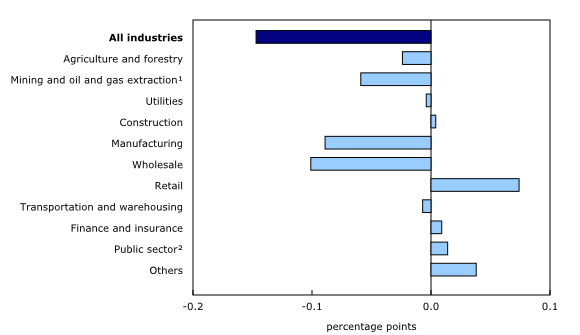Gross domestic product by industry, February 2016
Archived Content
Information identified as archived is provided for reference, research or recordkeeping purposes. It is not subject to the Government of Canada Web Standards and has not been altered or updated since it was archived. Please "contact us" to request a format other than those available.
Released: 2016-04-29
February 2016
-0.1% 
(monthly change)
After rising for four consecutive months, real gross domestic product edged down 0.1% in February. The output of goods-producing industries declined in February, while the output of service-producing industries was essentially unchanged.
After increasing 0.9% in January, the output of goods-producing industries contracted 0.6% in February primarily as a result of decreases in manufacturing and mining, quarrying, and oil and gas extraction. Declines were also registered in the agriculture and forestry sector as well as in utilities. Construction edged up.
The output of service-producing industries was essentially unchanged in February, after rising for four consecutive months. A notable decline in wholesale trade was offset by gains in retail trade and, to a lesser extent, the public sector (education, health and public administration combined) and accommodation and food services.
Wholesale trade contracts while retail trade expands
Wholesale trade contracted 1.8% in February after rising the previous three months. Most subsectors were down. The largest decline in terms of output came from wholesalers of machinery, equipment and supplies, followed by the motor vehicles and parts and building material and supplies subsectors.
Retail trade expanded 1.4% in February, after rising 1.6% in January. Notable increases were posted at clothing and clothing accessories stores, food and beverage stores, and general merchandise stores (which include department stores).
Manufacturing output falls
After rising the previous three months, manufacturing output fell 0.8% in February.
Durable-goods manufacturing was down 1.8% in February, after expanding for three consecutive months. The decline in February was mainly the result of a decrease in transportation equipment manufacturing, which was widespread across the subsector. The manufacturing of wood products, computer and electronic products, and furniture and related products was also down. In contrast, fabricated metal product manufacturing, primary metal manufacturing, machinery manufacturing and electrical equipment manufacturing were up.
Non-durable goods manufacturing rose 0.4%, a third consecutive monthly increase. This was the result of a gain in chemical manufacturing, mainly pharmaceutical and medicine manufacturing. In contrast, petroleum and coal products manufacturing and, to a lesser extent, food manufacturing posted declines.
Mining, quarrying, and oil and gas extraction declines
Mining, quarrying, and oil and gas extraction declined 0.8% in February, after increasing 1.0% in January.
Following a 1.9% increase in January, support activities for mining and oil and gas extraction retreated 5.1% in February as a result of declines in rigging and drilling services.
After expanding for four consecutive months, oil and gas extraction contracted 0.6%, mainly as a result of a 1.7% decline in non-conventional oil extraction. Conventional oil and gas extraction increased 0.4%.
Mining and quarrying (excluding oil and gas extraction) grew 0.5% as a result of an increase in metal ore mining. Decreases were registered in non-metallic mineral and coal mining.
Construction edges up
Construction edged up 0.1% in February. Repair construction and residential building construction increased, while non-residential building and engineering construction declined. For non-residential building construction, it was the seventh consecutive monthly decrease.
The output of real estate agents and brokers grew 1.5% as a result of increased activity in the home resale market.
The public sector edges up
The public sector (education, health and public administration combined) edged up 0.1% in February. Public administration and educational services were up, while health care services were down.
The finance and insurance sector edges up
The finance and insurance sector edged up 0.1% in February. Banking and insurance services increased, while financial investment services declined.
Other industries
Accommodation and food services rose 0.7%, as the increase in accommodation services outweighed a decline in the food services and drinking places industry.
Transportation and warehousing services declined 0.2% in February, after rising 1.1% in January. Lower pipeline transportation output contributed to the decrease.
Utilities decreased 0.2% in February. Natural gas distribution fell 3.8% as a result of declines in distribution across all customer types. The output of the electric power generation, transmission and distribution industry rose 0.4%.
Note to readers
The monthly gross domestic product (GDP) by industry data at basic prices are chained volume estimates with 2007 as the reference year. This means that the data for each industry and each aggregate are obtained from a chained volume index multiplied by the industry's value added in 2007. The monthly data are benchmarked to annually chained Fisher volume indexes of GDP obtained from the constant-price supply and use tables (SUT) up to the latest SUT year (2012).
For the period starting with January 2013, the data are derived by chaining a fixed-weight Laspeyres volume index to the prior period. The fixed weights are 2012 industry prices.
This approach makes the monthly GDP by industry data more comparable with expenditure-based GDP data, which are chained quarterly.
All data in this release are seasonally adjusted. For information on seasonal adjustment, see Seasonally adjusted data – Frequently asked questions.
For more information on GDP, see the video, "What is Gross Domestic Product (GDP)?"
Revisions
With this release of monthly GDP by industry, revisions have been made back to January 2015.
Each month, newly available administrative and survey data across various industries in the economy are integrated and result in statistical revisions. Updated and revised administrative data (including taxation statistics), new information provided by respondents to industry surveys, and standard changes to seasonal adjustment calculations are incorporated with each release.
For more information about monthly national GDP by industry, see the System of macroeconomic accounts module on our website.
Real-time CANSIM tables
Real-time CANSIM table 379-8031 will be updated on May 6. For more information, consult the document Real-time CANSIM tables.
Next release
Data on GDP by industry for March will be released on May 31.
Contact information
For more information, contact us (toll-free 1-800-263-1136; 514-283-8300; STATCAN.infostats-infostats.STATCAN@canada.ca).
To enquire about the concepts, methods or data quality of this release, contact Allan Tomas (613-790-6570), Industry Accounts Division.
- Date modified:




